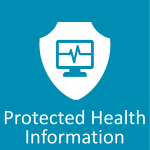Is Your Practice Protected?
Did you know… According to the Identity Theft Resource Center, 44% of all data breaches in 2013 were healthcare-related?
In April of 2014, the FBI warned healthcare providers that their cyber security systems were at risk to attacks by hackers compared with those of other industries. Microsoft recently shared research by Accenture that estimates healthcare providers could lose $305 billion in revenue from patients through medical identity theft. The scary part of healthcare identity theft is that it can be detected as much as eight months after the initial hack! WHOA! That means organizations may not realize that intruders are already functioning in their environment! It’s critical for healthcare organizations to verify their systems are secure.
Why is healthcare suddenly a target?
 Why now? For the past three years there has been an increase data breaches targeting healthcare. First, there is a contradiction between the need to safeguard data and the need of healthcare professionals to have quick access to patient records. Also, according to Fortinet, cyber criminals previously focused their efforts on retail and financial targets, then as credit card companies and banks implemented increasingly sophisticated systems for detecting fraud and dealing with data breaches, hackers are now turning their attention to an easier target, healthcare and Protected Health Information (PHI).
Why now? For the past three years there has been an increase data breaches targeting healthcare. First, there is a contradiction between the need to safeguard data and the need of healthcare professionals to have quick access to patient records. Also, according to Fortinet, cyber criminals previously focused their efforts on retail and financial targets, then as credit card companies and banks implemented increasingly sophisticated systems for detecting fraud and dealing with data breaches, hackers are now turning their attention to an easier target, healthcare and Protected Health Information (PHI).
Medical records contain a wealth of sensitive information that can be used for identity theft, and can be used undetected for some time, while a stolen credit cards can be quickly identified and closed. PHI becomes an even more attractive target because breached healthcare databases receive a very high payout on the black market. Even scarier for healthcare organizations, a PHI breech can result significant penalties for violations of HIPAA regulations and has the potential for destroying patient trust.
Why Vertilocity?
Protecting data isn’t just about responding to cyber criminals or staying HIPAA compliant. Practices that have focused on reactive measures must expand their efforts to include proactive approaches as well. Healthcare organizations are using the internet far differently than it was constructed to uphold. Where charts used to be kept on paper, in files, they are now kept on devices – causing the amount of connected devices at any given time in a medical practice or hospital to skyrocket. The internet, which practices may have set up to be for patient use in the waiting room, is now being used by every medical professional on most likely many devices per person.
Do you have internet usage policies in place? Do you know who is accessing your systems at any given time? How much more are you using the internet than you were five years ago? These questions pose serious threats to your practice if not answered properly.
The healthcare industry is uniquely vulnerable now, but there’s never been a better opportunity to set a new standard for security and privacy. We know how doctors work and how technology can allow you to improve patient care and security.
